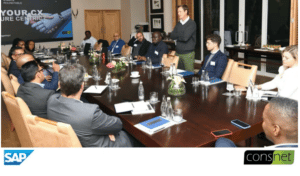 Having a great product or solution is only a piece of the puzzle when it comes to success, especially if your business or organisation is dependent upon customers to find long-lasting growth.
Having a great product or solution is only a piece of the puzzle when it comes to success, especially if your business or organisation is dependent upon customers to find long-lasting growth.
To ensure said growth, it is the customer experience (CX) element that requires the greatest amount of attention, refinement and fine tuning. As such, when considering the CX journey, an experience that is as frictionless and helpful as possible is the end goal, but companies should not stop there either.
To that end, the future should also play a key part when developing an effective CX journey.
This was one of the major talking points during a recent C-Suite roundtable hosted by SAP and bespoke software provider Consnet, where the pair listened to some of the CX pain points of other enterprises, as well as offering up their own insights on the matter.
Think about the destination
Unpacking some of the overarching problems that were highlighted by those in attendance in developing a CX journey, Dumisani Moyo, marketing director at SAP Africa, noted that legacy systems are a continuing issue for many.
Moyo also noted that it is not just the systems that are an area of concern, but also legacy in terms of the approach to disruption.
“As an example, if you think of legislation in the financial sector and how much of a hurdle it can present, fintech has found an effective way to negotiate that,” he illustrated.
“I think it is key when you talk about disruption, to zoom into the fact that technology enables good strategy. Customer strategy is not really a function of technology, and while technology can make it better, it ultimately enhances what your company needs to deal with, whether that be good or bad. There are countless examples of companies with vast resources and access to technology, but they simply cannot get it right,” he continued.
As such, Moyo emphasises the need to think about the future in approaching the CX journey, as those organisations saddled with legacy, both in terms of systems and its approach to technology, will ultimately never break free of the current customer experience model.
“When you think about the technology that enables your customer strategy, it is based on sound principles,” he stressed.
One of the other aspects that Moyo addressed as a direct result of the conversations that took place during the roundtable was that of omni-channel in terms of how the customer is viewed.
No singular view
“For me, it is not about a single view of a customer, it’s rather about developing a customer for life. In order to do that you need to have the right data, connect it correctly and then you need to understand the insights that are coming out of that data,” he explained.
“We have to think about how we unify the ecommerce experience. Not only that, but we also have to think about the traditional way that we take our value to the market. Things like how we bring our physical stores and operations to the online space, along with paying attention to the end-to-end value chain,” posited the SAP executive.
Another area he made particular mention of is trust in the CX journey. When you consider the desire to create lifelong customers, trust might be the most crucial ingredient, which once again feeds into the theme of the future as a central pillar in the development of a CX journey.
“Today’s customer does not just want to buy a car. They want to know where it was made, how it was made and whether it was done in a responsible way, so data becomes a necessary consideration for that aspect of the customer journey,” he added.
As such, there is much for businesses that deal with customers or have a service they wish to bring to the fore, to think about. In the view of SAP, Consnet and many C-Suite executives, building a solid CX journey requires forethought and an understanding of the destination, as well as the ride.
To find out how SAP and Consnet can assist your business in developing a winning CX journey, head here.



